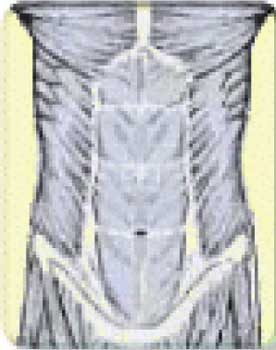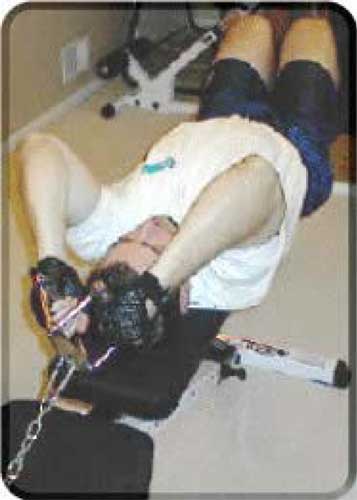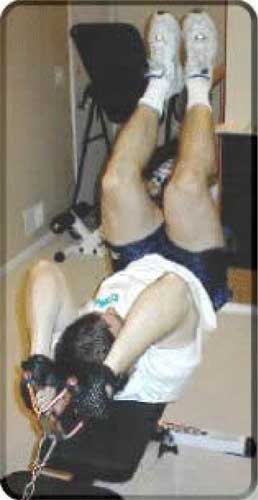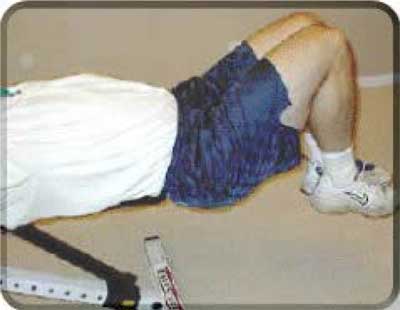Bench End Leg Raise/Cable Crunches

Why Is This Exercise So Effective?
This exercise works your abdominals from two directions in the same exercise, which is extremely difficult but extremely effective. The vast majority of abdominal exercises only work from one direction, e.g. the crunch works from the top down.
This exercise combines a lengthwise bench-end leg raise with the low pulley cable crunch. Your lower abs lift your legs up, giving you tension from the bottom up while your upper abs then perform a weighted crunch, giving you tension from the top down.
How To Do It
The best bench and cable setup to do this exercise on is the seated low row machine, though you can also set it up using a regular flat bench and a low pulley.
- Set the bench lengthwise for greatest stability. Don’t set up the bench perpendicular to the weight stack. If you place it this way, there is not enough surface area for you to maintain stability safely and you will fall over backwards the moment you grasp the cable handle.
- Use a rope attachment or close grip row attachment on the low pulley, setting the handles where you will be able to reach them.

- Set yourself on the end of the bench with your glutes off. Your lower back will be rounded over the end of the bench.
- Start with your feet on the ground. You will be starting the movement once you have the cable handle in your hands.
- Reach back and grip the rope/bar, holding the ends/handles near the top of your head. Use a moderate weight on the pulley.
- If you can’t reach back far enough to grab the rope/bar you can either have somebody hand it to you or you can try this trick: remove the pin from the stack, pull the weight up a few notches then put the pin back in. What this does is extend the reach of the cable so that you are able to grasp it by reaching up and back.
- Crunch up a little so the weight is not resting on the stack and you have tension in your abs. You should now lift your legs off the floor somewhat.

- Now, keeping your hands and upper abs exactly where they are, do the leg raise movement curling your lower back up and over the lip of the bench.
- Lower your legs but try not to let your feet touch the floor between reps in order to maintain tension on the abs. As shown in the video, however, you may choose to place your feet on the floor in between leg raises while you are doing the crunch phase.
- As you come down and your feet are getting close to the floor, start to do a cable crunch. Squeeze hard at the top of it. Your hips and lower back should be hooked over the end of the bench by this time, anchoring your lower body so that you don’t slide up the bench.
- Come down from the crunch without letting the plates touch on the stack, then immediately go into the leg raise again.
- Do this entire sequence without letting your feet touch the ground, or the plates on the cable rack touch each other.
How to incorporate this exercise into your workouts:
This exercise can be done as a stand-alone abdominal workout.
- It targets all the major muscle groups in the abs.
- I would recommend doing only one or two sets to absolute failure with this one.
- It is an excellent exercise to do if you are “crunched” for time yet still want a complete ab workout.
Common Errors
1. Incorrect timing
This movement is done as a one-two punch: legs go up right after torso goes down, legs come down, torso goes up. Altering the timing significantly can lead to strain on your back and can throw off your balance.
It will almost resemble a rocking motion like that of a rocking chair, however you won’t be relying on momentum to do the exercise.
2. Glutes not off bench

- The most effective position for the leg raise is with the glutes entirely off the bench. Imagine you are hooking your butt over the end of the bench.
- The edge of the bench should be just above your waistband. This allows for maximum flexion of the spine, which in turn gives your abdominals the greatest range of motion.
- Placing your body too high on the bench can strain your back and decrease the effectiveness of the movement.
3. Too much or not enough weight
- Using too much weight will limit the range of motion of your crunch and will most likely throw you off balance, causing the weight plates to touch between reps.
- Using too little weight will cause your body to dip forward when your legs come down from the leg raise.
- You must have enough weight there to keep yourself anchored but not so much that you can’t do the crunch properly.
- Generally, between 40 to 70 pounds is a good starting point, depending on your bodyweight.
Tricks
1. Thrusting the legs
While the standard leg raise is good, the leg raise with a thrust at the top is even better. Accomplishing the thrust is simple. At the top of the leg raise, simply pretend as though you are trying to put your footprints on the ceiling.
This thrust upwards adds another dimension of tension to the exercise.
2. Self spotting
You can spot yourself for more reps by using some of the momentum from the end of the negative of one phase and transferring it into momentum for the start of the next phase, e.g. when your legs come down, lock your abs near the bottom and transfer that momentum into your upper body for the crunch part of the movement.
- To do this, let your legs drop without trying to control the negative.
- Just before your legs hit, stop the movement with a muscle clench and transfer the momentum to your upper abs.
3. Crunching during the leg raise
For another extra hit, try crunching your upper body up at the top of the leg raise segment. To increase the resistance, use ankle weights (a dumbbell between your feet is not a good way to add extra resistance as the dumbbell can slip out easily and drop on you).
4. The twist
To hit your obliques and add a third dimension of tension to this exercise, rotate yourself as you thrust up from the leg raise. It will look as though trying to screw your feet into the ceiling. Alternate directions with each rep.




